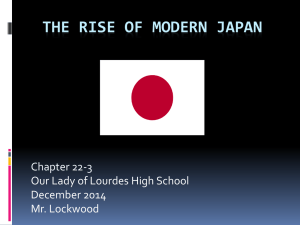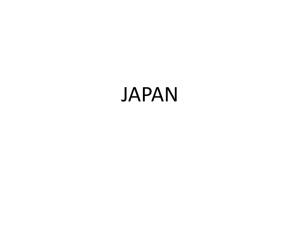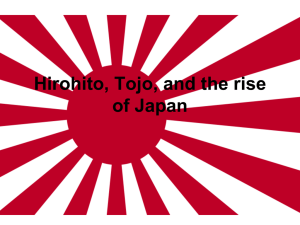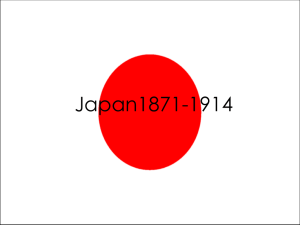Japan Modern Outline
advertisement
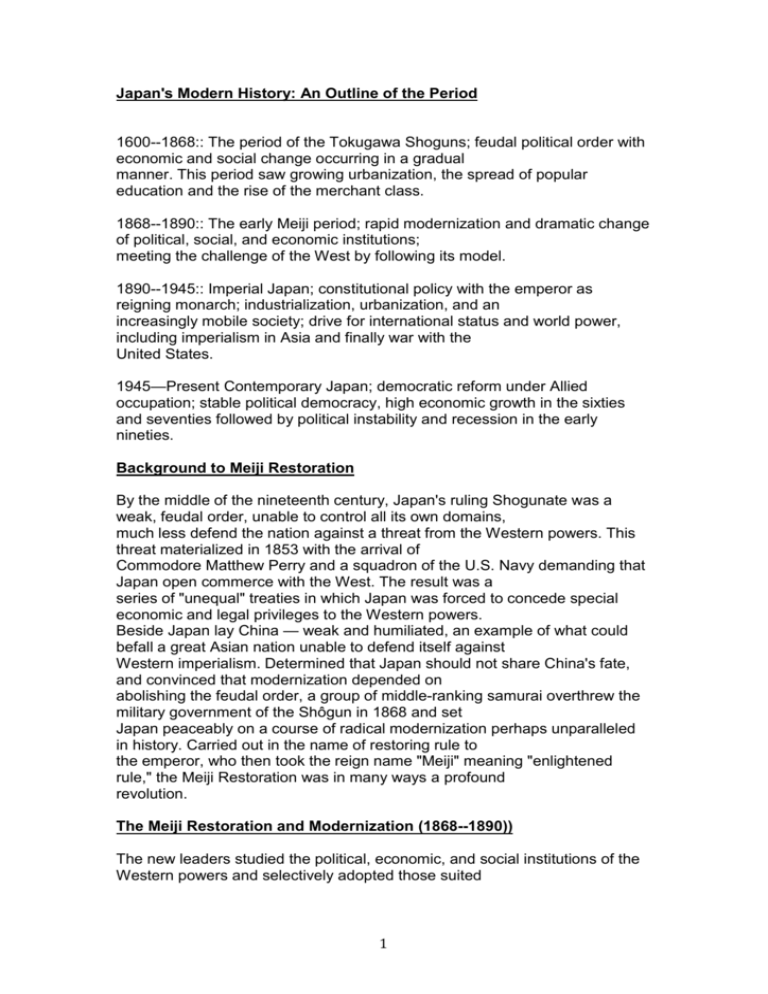
Japan's Modern History: An Outline of the Period 1600--1868:: The period of the Tokugawa Shoguns; feudal political order with economic and social change occurring in a gradual manner. This period saw growing urbanization, the spread of popular education and the rise of the merchant class. 1868--1890:: The early Meiji period; rapid modernization and dramatic change of political, social, and economic institutions; meeting the challenge of the West by following its model. 1890--1945:: Imperial Japan; constitutional policy with the emperor as reigning monarch; industrialization, urbanization, and an increasingly mobile society; drive for international status and world power, including imperialism in Asia and finally war with the United States. 1945—Present Contemporary Japan; democratic reform under Allied occupation; stable political democracy, high economic growth in the sixties and seventies followed by political instability and recession in the early nineties. Background to Meiji Restoration By the middle of the nineteenth century, Japan's ruling Shogunate was a weak, feudal order, unable to control all its own domains, much less defend the nation against a threat from the Western powers. This threat materialized in 1853 with the arrival of Commodore Matthew Perry and a squadron of the U.S. Navy demanding that Japan open commerce with the West. The result was a series of "unequal" treaties in which Japan was forced to concede special economic and legal privileges to the Western powers. Beside Japan lay China — weak and humiliated, an example of what could befall a great Asian nation unable to defend itself against Western imperialism. Determined that Japan should not share China's fate, and convinced that modernization depended on abolishing the feudal order, a group of middle-ranking samurai overthrew the military government of the Shôgun in 1868 and set Japan peaceably on a course of radical modernization perhaps unparalleled in history. Carried out in the name of restoring rule to the emperor, who then took the reign name "Meiji" meaning "enlightened rule," the Meiji Restoration was in many ways a profound revolution. The Meiji Restoration and Modernization (1868--1890)) The new leaders studied the political, economic, and social institutions of the Western powers and selectively adopted those suited 1 to their purpose. In 1889 a constitution was promulgated which established a parliamentary government but left it accountable to the emperor rather than to the people. Administrative power was centralized in a national bureaucracy which also ruled in the name of the emperor. The classes were declared equal, so that samurai and their lords lost their feudal privileges, while the role of merchants — formerly despised as profit hungry — began to be respected. The enthusiastic adoption of new Western technologies caused an explosion of industrial productivity and diversification. A national military and universal conscription were established. Compulsory public education was introduced both to teach the skills needed for the new nation and to inculcate values of citizenship in all Japanese. Imperial Japan; Industrialization and Expansion ((1890--1930)) This period was a time of social and economic change within the constitutional monarchy established in 1890. As the original architects of the Restoration died, the various branches of the government began competing for power. An oligarchy bound closely by its members' shared conception of national purpose was replaced by an aggregate of interest groups — the Parliament, civil bureaucracy, military, and Imperial Household — all vying for the ear of the Emperor in whose name they administered the government. Japanese industry expanded, both in light export industries like textiles, which were necessary to pay for the raw materials needed from abroad, and also in heavy industries like steel and shipbuilding. Cities grew, as more Japanese moved from farming into jobs in factories and offices. In the countryside larger landlords came to own more and more land, and the number of poor tenants increased. Always dependent on foreign trade, Japan was hard hit by the world depression that began in 1929. The farmers who had grown the silk that was exported to the United States found no market for their product once the roaring twenties and the craze for silk stockings collapsed with the stock market crash. Japan's dramatic economic growth slowed, and social problems increased, especially in the countryside. At the same time that the leaders of imperial Japan pursued modernization and economic growth, they continued to address the issue of Japan's unequal status in the international order. In 1894, more than forty years after Commodore Perry pried Japan open to the outside world, Japan finally succeeded in revising the unequal treaties so that it regained its legal parity with the Western powers. Japan fought a war against China in 1894-95 over the control of Korea and gained Taiwan, Japan's first colony. In 1902, Japan signed an alliance with Great Britain, which signified a dramatic increase in international status, and in 1904-5, Japan won a 2 war against Russia, one of the major Western powers. In the process Japan expanded its empire, annexing Korea in 1910. Japan was allied with the United States and Britain in World War I, and expected territorial gains at the Versailles peace conference in 1919. Instead Japan met with strong opposition from the United States, and again learned the lesson that the West regarded imperialism very differently if it was the imperialism of an Asian rather than a European power. The failure of the Japanese to get a clause on racial equality inserted into the covenant of the League of Nations was an insult that was compounded in 1924 when the United States barred all Japanese from immigration. The setbacks and insults from abroad, against a background of economic depression, sowed public frustration with the political leadership at home. Even more, military units under the field commands in Manchuria grew impatient with the politicians' apparent inability to translate any of their military victories into political gains. Increasingly, Japanese were persuaded by the militarists' contention that Japan's security lay in consolidating her access to markets and resources in Asia. Japan’s Quest for Power and WWII The impatience of field commanders in Manchuria finally showed in 1931, when they used a local provocation as an excuse to put all the Japanese territory in Manchuria under control of the military. The move presented Japan's civilian government at home with an accomplishment that it could not afford to ignore. The military-industrial machine went into high gear, pulling Japan out of its depression as it continued to expand Japanese hegemony across the Far East. As Holland, France, and Germany were enveloped in turmoil in Europe, Japan looked to replace them in Asia. Japanese troops invaded China in 1937, and French Indochina in 1940, setting up puppet governments to administer areas too vast to be controlled by the Japanese armies. Alarmed by Japan's increasing usurpation of Western prerogatives in the Far East — and disregard for the rights of the local populations — the United States delivered an ultimatum to Japan: steel and oil exports to Japan would be cut off unless Japan got out of China. In the context of rapidly worsening relations, Japan decided to make a daring surprise attack on Pearl Harbor in August 1941, where 90 percent of the U.S. Navy was deployed. The preemptive strike bought Japan time — it took the United States, many times its superior in industrial strength, a full year to gain the offensive on Japan. Japan's string of early successes — the Philippines, Hong Kong, British Malaya and Singapore, and the Dutch East Indies — left its navy scattered across the Pacific while its army was bogged down in China. When the United States recovered its forces lost in Pearl Harbor, its navy and army were able to 3 conduct an "island-hopping strategy" of cutting off the Japanese commands one by one from their supply routes. By 1945, the U.S. forces were close enough to launch damaging bombing attacks from nearby islands against Japan itself. Its cities devastated by fire bombing, its economy barely functioning and its people on the brink of starvation, the Japanese government still held out hope that with the assistance of the Russians, Swiss, or Swedes they would be able to negotiate an end to the war. Unaware of the secret agreement among Allies at Yalta, Japan was shocked when Russia too entered the war against Japan. Two days earlier, the United States had dropped the first atomic bomb on Hiroshima, a medium-size industrial city. The day after the Russian declaration of war, the second atomic bomb was dropped on Nagasaki, the port city where Japan had first opened itself to Westerners. Japan agreed to unconditional surrender and the emperor himself went on the radio to make the announcement of surrender to the Japanese people. Post-War Japan (1945--1989) For the next seven years, Allied powers occupied Japan. After Japan's military forces were demobilized and repatriated, the Occupation, led by General Douglas MacArthur of the U.S. army, turned to the problem of making Japan democratic with the hope that its people would never again be led to fight a war of aggression. To that end, in 1947 a new constitution was adopted with two key provisions: sovereignty was transferred from the emperor to the people, and Japan as a nation renounced war and the right to build a military force. Under land reform, tenant farmers were given the land they worked and industrial workers were allowed to form trade unions."Zaibatsu" or large business-combines which had been part of the military-industrial machine were partially dismantled. Democracy was popularized in the media and schools, and the "moral training" that had fostered extreme nationalism was abolished. Most of the reforms made under the Occupation have been retained by Japan. The United States changed some of the more liberal provisions it had encouraged early in the Occupation as it grew more fearful of Communism in the Cold War. With American support, Japan rebuilt many of its wartime industries to supply U.S. forces in the Korean War and entered into a security treaty with the United States which established Japan in an important role in America's Asian defense strategy. In 1952, the U.S. Occupation of Japan ended and by 1955 the Japanese economy had regained its highest prewar production levels. A stable political system was also established with the conservative and pro-American Liberal Democratic Party's control of the government. 4 From the sixties through the mid-eighties domestic politics were stable; the Liberal Democratic Party maintained a solid majority in the Diet (parliament) and emphasized close relations with the United States. Japan also achieved record economic growth — averaging 10 percent a year until the seventies. Its economy grew from one less productive than Italy to the third largest in the world, behind only the United States and the Soviet Union. Growth was especially strong in heavy industry, such as steel, chemicals and machinery, and in advanced technology. Almost totally dependent on imports for food and energy, Japan began to face increasing protectionism abroad and serious pollution problems at home. Although Japan has brought pollution under control, trade frictions continued. As one of the most advanced post industrial societies in the world, the Japanese people enjoyed prosperity and the benefits of a thriving middle-class society. 1989 to Present "In 1989, in an entirely accidental coincidence, the Shôwa emperor, Hirohito, died, and the Berlin Wall fell, both in the same year. The death of the emperor, who had come to the throne in 1926, meant the end in Japan of the long era that had included the war, the transwar, and the postwar as well. And the close of the Cold War in the West meant the end of the global geopolitical system that had provided Japan international shelter within the American imperium. Two years later the economic "bubble" burst, and Japan went into a lengthy recession. Another two years passed, and the Liberal Democratic Party "fell," much the way the Shogunate had collapsed so many years ago, without a revolution. Six prime ministers held office between 1989 and 1996, an orderly turnover that was nonetheless routinely described as political "chaos." Japanese society was aging rapidly, its elderly increasing, and its birthrate dropping. The "1.57 shock" of 1990 brought fertility well below the level required for demographic replacement. Even more shocking to some was the increasing number of younger urban women who were refusing to marry or choosing not to bear children. The Gulf War of 1991 administered an international shock to Japan's Constitution, raising the postCold-War question of sending uniformed troops to participate in peacekeeping operations abroad and challenging the customary practices of postwar pacifism. And the nations of Asia, now increasingly important to Japan's economic and geopolitical relations, made ever more insistent demands on the Japanese to acknowledge and apologize for their earlier acts of colonialism and wartime aggression. The years following 1989 will one day be viewed, no doubt, as another historical conjuncture of global import, not simply because the Cold War ended, but because so many other things were happening at the same time." 5 * Taken from "Japan's Modernities, 1850's-1990's," by Carol Gluck, in Asia in Western and World History: A Guide for Teaching, eds. Ainslie T. Embree and Carol Gluck, Armonk: M.E. Sharpe, 1997 6
